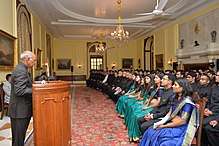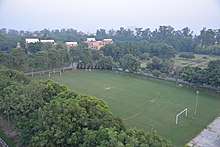Central Public Works Department
 | |
 | |
| Service Overview | |
|---|---|
| Abbreviation | CPWD |
| Formed | 1854 |
| Country |
|
| Group 'A' Services |
Central Engineering Service (CES) Central Electrical & Mechanical Engineering Service (CEMES) Central Architects Service (CAS) |
| Training Ground | National CPWD Academy, Ghaziabad |
| Cadre Controlling Authority | Ministry of Housing and Urban Affairs |
| Minister Responsible | Narendra Modi, Prime Minister of India and Minister of Ministry of Housing and Urban Affairs, Hardeep Singh Puri |
| Legal personality | Governmental; civil service |
| Duties | Execution of Public Works for Government of India |
| Cadre strength | 5400 approx |
| Mode of Selection |
Indian Engineering Services Exam for Group 'A' Post Staff Selection Commission JE Exam for Group 'B' Post |
| Associations |
Central Engineering Service Group 'A' (Direct Recruit) Association |
| Notable Officers | Prabhakar Singh (Director General) |
| Head of the civil services | |
| Pradeep Kumar Sinha, IAS | |
The Central Public Works Department of India (Hindi: केंद्रीय लोक निर्माण विभाग), commonly referred to as the CPWD, is a premier Central Government authority in charge of public sector works. The Central Public Works Department, under the Ministry of Urban Development now MoHUA (Ministry of Housing and Urban Affairs), deals with buildings, roads, bridges, flyovers, complicated structures like stadiums, auditoriums, laboratories, bunkers , border fencing, border roads (hill roads), etc. CPWD came into existence in July 1854 when Lord Dalhousie established a central agency for execution of public works and set up Ajmer Provincial Division. It has now grown into a comprehensive construction management department, which provides services from project concept to completion, and maintenance management.
It is headed by the Director General (DG) who is also the Principal Technical Advisor to the Government of India. The regions and sub-regions are headed by Special DGs and Additional DGs respectively, while the zones in all state capitals (except a few) are headed by Chief Engineers. Now A Days, a new post of Chief Project Manager (CPM) has been created to head major prestigious projects of CPWD. CPMs are equivalent to the rank of Chief Engineers in CPWD. With country wide presence, the strength of CPWD is its ability to undertake construction of Complex Projects even in difficult terrains and maintenance in post construction stage.[1]
It is the prime engineering department of Government of union of India and its specifications and manuals are followed by local public works departments and engineering wing of other departments.
CPWD consists of three wings in execution field:
1) B&R (Buildings and Roads)
2) E&M (Electrical and Mechanical)
3) Horticulture
History
Centralized public works in India can be traced to efforts of Lord Dalhousie and Sir Arthur Cotton in the mid 19th century. Sir Arthur Cotton sums up the early policy of the East India Company rulers thus,[2][3]
Public works have been almost entirely neglected throughout India. The motto hitherto has been: Do nothing, have nothing done, let nobody do anything. Bear any loss, let the people die of famine, let hundreds of lakhs be lost in revenue for want of water or roads, rather than do anything.
– Arthur Cotton (1854)[2]
Lord Dalhousie established the Central Public Works Department, and irrigation projects were among the earliest to be started.[4]
Public Works Department was formally established in the year 1854 in the sixth year of Lord Dalhousie’s tenure as Governor General. In the minutes of meeting held on 12 July 1854 the Governor General resolved that a central agency be provided by creating an office of Secretary to the Government of India in Department of Public Works. The note recorded by Lord Dalhousie was as under:
“The organization of the Department of Public Works in the Indian Empire will be incomplete unless it shall be provided for the Supreme Government itself come agency by which it may be enabled to exercise the universal control confided to it over public works in India with the best of scientific knowledge with authority and system. The Government of India shall no longer be dependent on expedients, but should be provided with a permanent and highly qualified agency to assist in the direction of this important branch of public affairs. I have, therefore, now to propose that such an agency should be provided by creating an office of the Secretary to Government of India in the Department of Public Works. The person who holds it should always be a highly qualified officer of the Corps of Engineers.”
Colonel W.E. Baker of the Bengal Engineers was accordingly appointed first Secretary to the Department of Public Works, this is the genesis of the Central Public Works Department.[5]
CPWD has PAN India presence and has ability to undertake construction of complex projects even in difficult terrain and maintenance in post construction stage. CPWD had been involved in construction of stadiums and other infrastructure requirements for Asian Games 1982 and Commonwealth Games 2010.
Zeal and spirit of endeavour of CPWD officers have taken the organization beyond national boundaries. CPWD had also constructed the Afghan Parliament Building.
Functions of CPWD
Following are the core functions of CPWD
- Design, construction and maintenance of Central Government non- residential buildings other than those for Railways, Communications,Atomic Energy, Defense Services, All India Radio, Doordarshan and Airports (IAAI & NAA).
- Construction and maintenance of residential accommodation meant for Central Government Employees.
- Construction works for Central Police Organizations i.e. CRPF, CISF, BSF, and ITBP as well as maintenance of assets of CRPF and CISF assigned to CPWD.
- Construction works for establishments under the Cabinet Secretariat i.e. SSB, SIB etc.
- Construction works for public sector undertakings not having their engineering organization, other Government Organisations, Autonomous bodies and institutions as deposit work. “Deposit Works” are such works, which are undertaken at the discretion of the Director General, CPWD for which the outlay is provided wholly or in part from
- a) Funds of a public nature but not included in the financial estimates and accounts of the Union of India.
- b) Contributions from the public.
- Providing consultancy services in planning, designing and construction of civil engineering projects, as and when required by public undertaking and other autonomous bodies.
- Construction of Embassy and other buildings / projects abroad at the request of Ministry of External Affairs and other Ministries.
- Defence / Security related works assigned by the government such as border fencing & flood lighting works and Indo China Border Road Works (ICBR).
- Construction of roads under PMGSY and RSVY programme. To undertake works under PPP/Alternate Funding mode.
Delhi PWD
The Public Works Department of Government of Delhi is manned by officers of CPWD, who are engaged in construction and maintenance of residential and non- residential buildings, roads (excluding those under Municipal Corporation) in the state of Delhi.
Consultation & advisory functions
The Director General of CPWD functions as Technical Advisor to the Government of India and is consulted in various technical matters relating to construction and maintenance. The Ministry of External Affairs consults CPWD with regard to construction and maintenance of the Embassy buildings abroad. As Technical Advisor to the Government of India, the Director General of CPWD or his nominee is associated with technical bodies and / or Standing Committees of various Institutions and Organisations. Some of the important organizations are:
- Central Building Research Institute, Roorkee
- Hindustan Prefab Limited, Delhi
- Indian Institute of Technology, Delhi
- Indian National Group of the International Association for Bridges & Structural Engineering
- Indian National Society of Soil Mechanics and Foundation Engineering
- Indian Roads Congress
- Bureau of Indian Standards
- Indian Institute of Public Administration
- Indian Council for Foresting Research Education
- National Buildings Organisation
- National Productivity Council
- National Defence Academy, Khadakvasla
- Central University of Rajasthan
- Central University of Haryana
Recruitment

The recruitment as entry level for middle management is made through Engineering Services Examination (ESE) conducted by Union Public Service Commission. Only top candidates in ESE get a chance to join CPWD strictly on merit basis. During probation period, the selected candidates undergo rigorous training of 35 weeks at National CPWD Academy situated in Ghaziabad (U.P). which transforms them into competent Architects/Engineers cum bureaucrats. During the normal career progression one rises to Chief Architect/Engineer, then to Additional Director General and further to Special Director General. The apex level post in CPWD is of Director General, CPWD who also acts as technical advisor to the Government of India. Recently the Government of India has given the approval for creation of one more post of Director General (Planning). So from now onwards CPWD has two Director General Posts.
The job in CPWD is challenging yet rewarding. With pan India presence, CPWD has been involved in construction of strategically important mega projects all over the country including border areas. CPWD is well known for quality construction and timely completion of projects following which it has huge list of successful projects and departments as well as clients which it has served.
There are three cadres in CPWD:
1) CAS (Central Architecture Services)

2) CES (Central Engineering Services) for Civil Engineers
3) CEMES (Central Electrical and Mechanical Engineering Services) for Mechanical & Electrical Engineers
These are Group A Civil Services. (List of all Group A Civil Services: Civil Services of India)
Upon confirmation of service, a CPWD officer through Engineering Services Exam serves as an Assistant Executive Engineer for a period of 4 years which include 35 weeks of Foundation Training at the National CPWD Academy, Ghaziabad. In field, an Assistant Executive Engineer heads the entire Sub-Division. After the completion of 4 years, the officer is promoted to the grade of Executive Engineer which is equivalent to the Under Secretory to Government of India. Executive Engineer is the most challenging post in CPWD as the entire burden of the project is on him.
Training

National CPWD Academy is a Training Institute of Central Public Works Department (CPWD) which primarily focuses on the training needs of Group ‘A’ officers of CPWD. Originally a training cell was set up in New Delhi in year 1965 for foundation training of Group ‘A’ officers. This training cell was developed into a full-fledged Training Institute at Ghaziabad which started functioning in 1995. The CPWD training Institute was renamed as National CPWD Academy in the year 2016.
The National CPWD Academy looks after the training needs of Engineers, Architects, Horticulturists all across the country. The main academy is located at Kamla Nehru Nagar, Hapur Road, Ghaziabad (U.P.). Regional Training Institutes are located in the four metros i.e. New Delhi, Mumbai, Kolkata and Chennai. The National CPWD Academy is located in a lush green, serene, salubrious and pollution free environment spread over 30 acres of land in Kamla Nehru Nagar, Ghaziabad nearly 6 km (3.7 mi). from Ghaziabad Railway Station, 30 km (19 mi). from New Delhi Railway Station and about 50 km (31 mi) from Indira Gandhi International Airport, New Delhi.

The academy imparts training/refresher courses in all the aspects of public works. The academy conducts training programs, workshops, brain-storming sessions, seminars etc. to upgrade the techno-managerial skills of CPWD officers as well as officers of other Central Government Departments, State Governments and PSUs etc. The training programs are conducted in diverse streams such as Civil Engineering, Electrical and Mechanical Engineering, Architecture, IT Applications and Management Techniques. A number of new courses on Green Buildings, their rating system and certification, energy efficient buildings, conservation of heritage buildings etc. have been introduced to cater to the current changing construction scenario.
- Objectives

• To train each and every employee from his induction into the department till the end of his career with an endeavour to ensure that the employees get a chance to participate in a properly structured training process to realize their full potential.
• To ensure that the officers are kept abreast with the changing technological scenario through refresher training courses to update their knowledge base towards emerging technologies & innovative materials.
• Enable CPWD management to implement and execute it’s Human Resources strategic objectives.
• Develop skills and competence in the workplace.
- Other accolades
Centre of Excellence for Green Building Construction

The Academy has achieved the distinction of being declared as “Centre of Excellence” by MNRE for promoting Green Building Construction.
National Resource Institute for participation in NPCBEERM
The Academy has been enlisted by MHA as National Resource Institute to participate in NPCBEERM (National Programme for capacity building of Engineers in Earthquake Risk Management).
National Resource Institute for Capacity Building under “Sugamya Bharat Abhiyan”
National CPWD Academy has also been declared National Resource Institute for Capacity building in Access Audit under “Sugamya Bharat Abhiyan” by Ministry of Social Justice & Empowerment.

- Regional Training Institutes (RTIs)
To cater the training needs of Group B & C officials of the department, four Regional Training Institutes are functioning at following locations:
- Northern Region - R.K.Puram, New Delhi
- Western Region - New Marine Lines, Mumbai
- Eastern Region - Salt Lake City, Kolkata
- Southern Region - Besant Nagar, Chennai
These institutes conduct training courses for Group B & C officials. Workers Training Centres at above locations are also part of Regional Training Institutes. Workers Training Centres impart skill improvement training to workers in various trades like mason, carpenter, plumber, mali, electrician, wireman etc. (erstwhile Group D staff). The skill development courses for workers are also conducted in association with Construction Industry Development Council (CIDC). After completion of the training, certification of the workers is also done through IGNOU.
Designations and career progression
The various posts held by CPWD Gazetted Officers directly recruited through Engineering Services Examination is given in the table below.
| Position in the Government of India | Pay Scale and Pay Level as per 7th CPC | Position in the Central Government[6] |
|---|---|---|
| Director General (Apex Scale) | 80000 (Pay Level 17) | Secretary |
| Special Director General | 75500-80000 (Pay Level 16) | - |
| Additional Director General | 67000-79000 (Pay Level 15) | Additional secretary |
| Chief Engineer | 37400-67000 + 10000 Grade Pay (Pay Level 14) | Joint secretary |
| Superintending Engineer | 37400-67000 + 8700 Grade Pay (Pay Level 13) | Director |
| Executive Engineer (NFU) | 15600-39100 + 7600 Grade Pay (Pay Level 12) | Deputy secretary |
| Executive Engineer | 15600-39100 + 6600 Grade Pay (Pay Level 11) | Under secretary |
| Assistant Executive Engineer (Entry Level) | 15600-39100 + 5400 Grade Pay (Pay Level 10) | Assistant secretary |
State Public Works Departments in India
- Karnataka Public Works Department
- Kerala Public Works Department
- Tamil Nadu Public Works Department
- Uttar Pradesh Public Works Department
- Maharashtra Public Works Department
- Roads and Buildings Department, Gujarat
- Delhi Public Works Department
- Madhya Pradesh Public Works Department
References
- ↑ "CPWD WORKS MANUAL • 2012" (PDF).
- 1 2 Gilmartin, David (2015). Blood and water : the Indus River Basin in modern history. Oakland, California: University of California Press. p. 105. ISBN 978-0-520-28529-3.
- ↑ Economic History of India: 1857-1956. Allied Publishers.
- ↑ Gilmartin, David (2015). Blood and Water: the Indus River Basin in modern history. Oakland, California: University of California Press. p. 106. ISBN 978-0-520-28529-3.
- ↑ "Central Public Works Department". cpwd.gov.in. Retrieved 2016-12-07.
- ↑ "Service Profile for the Indian Administrative Service" (PDF). Department of Personnel and Training, Government of India. Retrieved 13 August 2017.